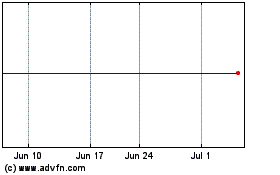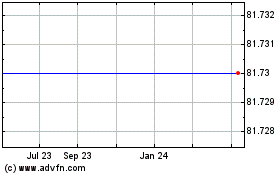Environmental Regulations May Spur Power Market Recovery
May 12 2011 - 2:54PM
Dow Jones News
New U.S. environmental regulations could prove far more
expensive for power companies than the government projected, but
the changes also may speed up a recovery for the whole
industry.
The Obama administration proposed a rule in March to cut toxic
air emissions by 91% at coal-fired power plants in 2015 as a way to
improve the environment and reduce health-care costs. It could
arguably be the most cumbersome of the upcoming environmental rules
because companies may be required buy costly new equipment for
plants or shut them down, industry executives have said.
Federal regulators are also expected to layer on other air and
water restrictions next year.
Altogether, these rules are the "most demanding in the last
decade" and could fuel a recovery in an oversupplied market, said
UBS Investment Research analyst Julien Dumoulin-Smith. "This is the
golden goose."
Demand for electricity fell sharply with the housing crisis and
economic downturn and is recovering slowly. Power producers have
been reluctant to cut supply, even as electricity prices have
fallen. The regulations would force the producers to close outdated
plants, reducing supply and driving the cost of electricity
higher.
In total, the new Environmental Protection Agency regulations
could take 30 to 70 gigawatts off the market, which is 10% to 22%
of the nation's coal plants, power executives and analysts say.
The EPA estimated the toxic-air rule alone would cost the
industry $11 billion and cause 3% of U.S. coal generation to go
offline, yielding $140 billion in annual health-care savings by
reducing Americans' exposure to mercury and acid gases that
contribute to heart disease and cancer.
Critics say the costs could be higher for power companies
because the EPA isolates the cost per rule, instead of looking at
the costs of all of the proposed changes together.
An EPA spokeswoman said in an emailed statement that there is
"no reason to think that the EPA's estimates are inaccurate in any
way, but before we finalize the rule we're going to review and
consider what others are modeling."
The power industry is modeling different scenarios to determine
how much extra cost they can absorb.
GenOn Corp. (GEN), a merchant power generator that relies on
market prices to make a profit rather than utility rates, will
likely be forced to retire some plants. But Chief Executive Edward
Muller said the earnings hit would be "more than offset by higher
earnings from increases in market prices a result of industry
retirement."
Exelon Corp. (EXC), the nation's largest operator of nuclear
plants, and Constellation Energy Group. (CEG) stand to benefit from
stricter rules because most of their electricity already comes from
cleaner-burning sources. Utilities including American Electric
Power (AEP), Duke Energy Corp. (DUK) and Southern Co. (SO) are
asking for more time to implement the rules.
"There is no legal flexibility to change the timeline unless the
law is changed," said Hugh Wynne, senior research analyst at
Sanford C. Bernstein & Co. But the EPA can grant a one-year
extension and ultimately Congress does have the purview to make
changes, Southern CEO Tom Fanning recently said.
AEP CEO Mike Morris called the EPA's existing timeline a "train
wreck" precisely because a surge of shutdowns would create grid
reliability problems and hurt the economy.
"We can get everybody to where they want to go environmentally
by 2020," Morris said.
AEP estimated that EPA regulations would cost it between $5
billion and $11.2 billion depending on the timeline and the scope
of the rules that are implemented. These costs would be passed on
to AEP's utility customers in the form of higher rates.
Not every coal-power generator will feel the heat from higher
costs, though. The EPA's rules has "bifurcated" coal generators by
targeting those that use sulfur-rich Appalachian coal for the use
of scrubbers, said Dumoulin-Smith of UBS.
The federal agency is using sulfur dioxide as proxy for
measuring acid gases so plants that use low-sulfur Powder River
Basin coal from Wyoming don't face the same cost burdens. As a
result, NRG Energy Inc. (NRG), a merchant generator that analysts
said could have been the most exposed to the EPA regulations, said
it no longer has to spend an additional $900 million to $1 billion
on environmental upgrades on top of its current spending plan of
$720 million.
-By Naureen S. Malik, Dow Jones Newswires; 212-416-4210;
naureen.malik@dowjones.com
American Electric Power (NYSE:AEP)
Historical Stock Chart
From Mar 2024 to Apr 2024

American Electric Power (NYSE:AEP)
Historical Stock Chart
From Apr 2023 to Apr 2024
